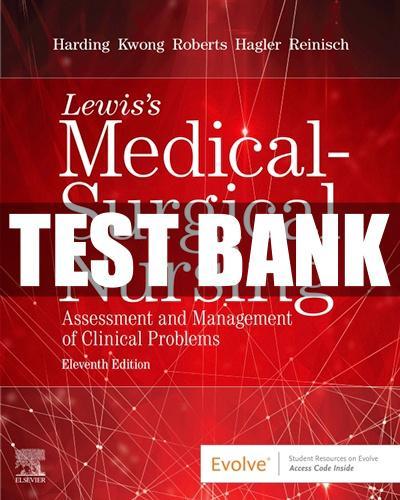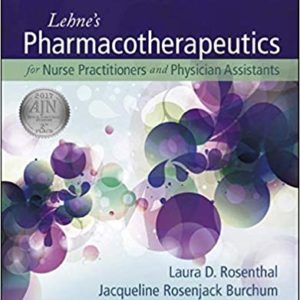- You cannot add another "TEST BANK nurs 500 ALL IN ONE STUDY GUIDE" to your cart. View cart
Test Bank Medical Surgical Nursing Concepts for Interprofessional Collaborative Care 9th Edition
$10
Description
Chapter 01: Overview of Professional Nursing Concepts for Medical-Surgical Nursing
Chapter 03: Common Health Problems of Older Adults
Chapter 06: Rehabilitation Concepts for Chronic and Disabling Health Problems
Chapter 08: Concepts of Emergency and Trauma Nursing
Chapter 09: Care of Patients with Common Environmental Emergencies
Chapter 11: Assessment and Care of Patients with Fluid and Electrolyte Imbalances
Chapter 13: Infusion Therapy
Chapter 14: Care of Preoperative Patients Chapter 15: Care of Intraoperative Patients
Chapter 18: Care of Patients with Arthritis and Other Connective Tissue Diseases
Chapter 20: Care of Patients with Hypersensitivity (Allergy) and Autoimmunity
Chapter 22: Care of Patients with Cancer
Chapter 24: Assessment of the Skin, Hair, and Nails
Chapter 27: Assessment of the Respiratory System
Chapter 28: Care of Patients Requiring Oxygen Therapy or Tracheostomy
Chapter 32: Care of Critically Ill Patients with Respiratory Problems
Chapter 34: Care of Patients with Dysrhythmias
Chapter 38: Care of Patients with Acute Coronary Syndromes
Chapter 40: Care of Patients with Hematologic Problems
Chapter 42: Care of Patients with Problems of the CNS: The Brain
Chapter 44: Care of Patients with Problems of the Peripheral Nervous System
Chapter 46: Assessment of the Eye and Vision
Chapter 47: Care of Patients with Eye and Vision Problems
Chapter 48: Assessment and Care of Patients with Ear and Hearing Problems
Chapter 50: Care of Patients with Musculoskeletal Problems
Chapter 56: Care of Patients with Noninflammatory Intestinal Disorders
Chapter 59: Care of Patients with Problems of the Biliary System and Pancreas
Chapter 62: Care of Patients with Pituitary and Adrenal Gland Problems
Chapter 63: Care of Patients with Problems of the Thyroid and Parathyroid Glands
Chapter 65: Assessment of the Renal/Urinary System
Chapter 68: Care of Patients with Acute Kidney Injury and Chronic Kidney Disease
Chapter 70: Care of Patients with Breast Disorders
Test Bank – Medical-Surgical Nursing: Concepts for Interprofessional Collaborative Care 9e 3
Chapter 01: Overview of Professional Nursing Concepts for Medical- Surgical Nursing
MULTIPLE CHOICE
1. A nurse wishes to provide client-centered care in all interactions. Which action by the nurse best demonstrates this concept?
a. Assesses for cultural influences affecting health care
b. Ensures that all the clients basic needs are met
c. Tells the client and family about all upcoming tests
d. Thoroughly orients the client and family to the room
ANS: A
Competency in client-focused care is demonstrated when the nurse focuses on communication, culture, respect compassion, client education, and empowerment. By assessing the effect of the clients culture on health care, this nurse is practicing client-focused care. Providing for basic needs does not demonstrate this competence.
Simply telling the client about all upcoming tests is not providing empowering education. Orienting the client and family to the room is an important safety measure, but not directly related to demonstrating client-centered care.
DIF: Understanding/Comprehension REF: 3
KEY: Patient-centered care| culture MSC: Integrated Process: Caring NOT: Client Needs Category: Psychosocial Integrity
2. A nurse is caring for a postoperative client on the surgical unit. The clients blood pressure was 142/76 mm Hg 30 minutes ago, and now is 88/50 mm Hg. What action by the nurse is best?
a. Call the Rapid Response Team.
b. Document and continue to monitor.
c. Notify the primary care provider.
d. Repeat blood pressure measurement in 15 minutes.
ANS: A
The purpose of the Rapid Response Team (RRT) is to intervene when clients are deteriorating before they suffer either respiratory or cardiac arrest. Since the client has manifested a significant change, the nurse should call the RRT. Changes in blood pressure, mental status, heart rate, and pain are particularly significant.
Documentation is vital, but the nurse must do more than document. The primary care provider should be notified, but this is not the priority over calling the RRT. The clients blood pressure should be reassessed frequently, but the priority is getting the rapid care to the client.
DIF: Applying/Application REF: 3
KEY: Rapid Response Team (RRT)| medical emergencies MSC: Integrated Process: Communication and Documentation
NOT: Client Needs Category: Physiological Integrity: Physiological Adaptation
3. A nurse is orienting a new client and family to the inpatient unit. What information does the nurse provide to help the client promote his or her own safety?
a. Encourage the client and family to be active partners.
b. Have the client monitor hand hygiene in caregivers.
c. Offer the family the opportunity to stay with the client.
d. Tell the client to always wear his or her armband.
ANS: A
Each action could be important for the client or family to perform. However, encouraging the client to be active in his or her health care as a partner is the most critical. The other actions are very limited in scope and do not provide the broad protection that being active and involved does.
DIF: Understanding/Comprehension REF: 3 KEY: Patient safety
lOMoARcPSD|6672187
Test Bank – Medical-Surgical Nursing: Concepts for Interprofessional Collaborative Care 9e 4
MSC: Integrated Process: Teaching/Learning
NOT: Client Needs Category: Safe and Effective Care Environment: Safety and Infection Control
4. A new nurse is working with a preceptor on an inpatient medical-surgical unit. The preceptor advises the student that which is the priority when working as a professional nurse?
a. Attending to holistic client needs
b. Ensuring client safety
c. Not making medication errors
d. Providing client-focused care
ANS: B
All actions are appropriate for the professional nurse. However, ensuring client safety is the priority. Up to 98,000 deaths result each year from errors in hospital care, according to the 2000 Institute of Medicine report. Many more clients have suffered injuries and less serious outcomes. Every nurse has the responsibility to guard the clients safety.
DIF: Understanding/Comprehension REF: 2 KEY: Patient safety
MSC: Integrated Process: Nursing Process: Intervention
NOT: Client Needs Category: Safe and Effective Care Environment: Safety and Infection Control
5. A client is going to be admitted for a scheduled surgical procedure. Which action does the nurse explain is the most important thing the client can do to protect against errors?
a. Bring a list of all medications and what they are for.
b. Keep the doctors phone number by the telephone.
c. Make sure all providers wash hands before entering the room.
d. Write down the name of each caregiver who comes in the room.
ANS: A
Medication errors are the most common type of health care mistake. The Joint Commissions Speak Up campaign encourages clients to help ensure their safety. One recommendation is for clients to know all their medications and why they take them. This will help prevent medication errors.
DIF: Applying/Application REF: 4
KEY: Speak Up campaign| patient safety MSC: Integrated Process: Teaching/Learning
NOT: Client Needs Category: Safe and Effective Care Environment: Safety and Infection Control
6. Which action by the nurse working with a client best demonstrates respect for autonomy?
a. Asks if the client has questions before signing a consent
b. Gives the client accurate information when questioned
c. Keeps the promises made to the client and family
d. Treats the client fairly compared to other clients
ANS: A
Autonomy is self-determination. The client should make decisions regarding care. When the nurse obtains a signature on the consent form, assessing if the client still has questions is vital, because without full information the client cannot practice autonomy. Giving accurate information is practicing with veracity.
Keeping promises is upholding fidelity. Treating the client fairly is providing social justice.
DIF: Applying/Application REF: 4
KEY: Autonomy| ethical principles MSC: Integrated Process: Caring
NOT: Client Needs Category: Safe and Effective Care Environment: Management of Care
7. A student nurse asks the faculty to explain best practices when communicating with a person from the lesbian, gay, bisexual, transgender, and queer/questioning (LGBTQ) community. What answer by the faculty is most accurate?
a. Avoid embarrassing the client by asking questions.
b. Dont make assumptions about their health needs.
c. Most LGBTQ people do not want to share information.
You must be logged in to post a review.





Reviews
There are no reviews yet.